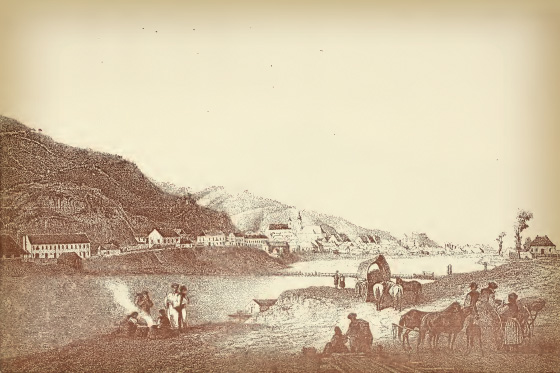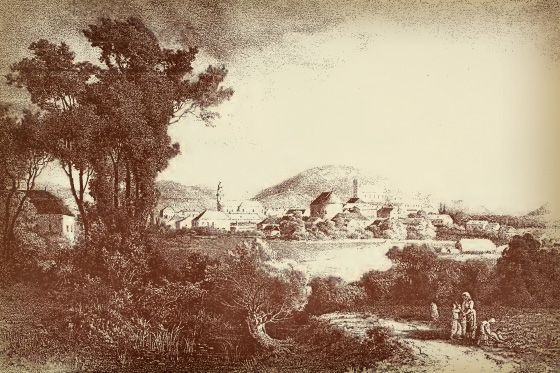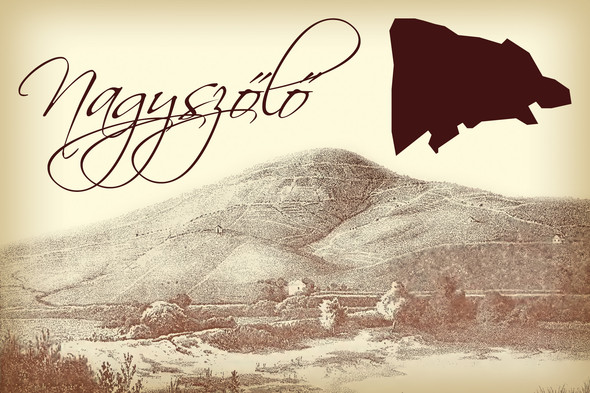Nagyszőlő has always been dwarfed by the better-known Hétszőlő. Although, it was never predestined to be like this seeing that it had a rather long and extraordinarily rich history. From the 17th century onwards, Nagyszőlő has been classified as a 1st class vineyard. Moreover, just like Hétszőlő, Nagyszőlő was also the integral part of the historical Mézesmál vineyard, or in Latin, the "promóntorium". Written sources referred to Mézesmál as early as the 15th century, though at that time it was known by the name of Mezezmaal. In 1411, Mézesmál was first mentioned in connection with a local aristocrat widow who donated territories to the monastery of the Pauline Fathers. Geographically speaking, Mézesmál consisted of the south-eastern, southern and south-western parts of the present-day Kopasz-hegy, located somewhere between the villages Tokaj and Tarcal.
The historical Mézesmál’s division began in the last third of the 15th century. At that time, the list of owners included the aristocrat Szapolyai family, the parishes of Tarcal and Tokaj, the gentries of the estate of Zemplen as well as the Pauline Father’s monasteries in Lechnitz, Karthauz, Sajólád and Tokaj. In the end of the 15th century, affluent citizens of Košice (who were frequently referred to as “outsider owners”, or extraneus, due to their place of residency) started to present themselves as owners of smaller lands. What is more, even Košice, the free royal city, purchased extensive vineyards form the residents of Tarcal and Tokaj. In the 15th century, Mézesmál reached a significant milestone when the Garay family acquired ownership at the territory. Though, it is to be highlighted that this Garay family is only a distant relative of the aristocrat branch of the Garay family, which fell into disgrace during the ruling of Mátyás I (Hunyadi) (1458-1490) and so was deprived of all their territories. What is more, in 1481, by the death off Jób Garay, this Garay family’s spear side died off.
In any case, at the turn of the 15th and 16th centuries, the aristocrat branch of the Garay family acquired ownership of numerous vineyards on the borders of Tarcal, Tállya, Tokaj and Tolcsva. In 1502, owing to their previous property purchases from local aristocrats and citizens of Košice, the Garay family melted all their lands in Mézesmál into one. Today, this territory is known by the name of Hétszőlő (Hethzelew, Hethzewllew, Hethzeulleu, Hethszőllő and Hétszőllő).

The birth of today’s Nagyszőlő is closely related to Hétszőlő, seeing that in the first decades of the 16th century, most probably before the Battle of Mohács, the Garay family separated a large piece of land from Hétszőlő which they started to call Nagyszőlő (vinea Naghzelew in Mezesmaal). Despite all of this, the first concrete reference to the existence of Nagyszőlő was made considerably late, in 1567 when the family made a listing of their properties. At that time, Nagyszőlő was mentioned as being one of the most important vineyards (vinea allodialis).
Having been in possession of great business skills, the Garay family sold a piece of Nagyszőlő to the royal family. Soon, this land was melted into the Nagy Kúria, owned by king and emperor Miksa II (Habsbourg) (1564-1576). In 1576, this piece of land of the Nagyszőlő (vinea dicta Nagyzeőleő) was purchased by the Bornemissza family. Though, in 1617, the family died off. In his testament, János Bornemissza named the Lónyay family as heir. However, it was vetoed by Gábor Bethlen (1580-1629) and, in 1620, he confiscated this land from the Lónyay family.
On the 15th of 1571, after the death of Máté Garay, his son János Garay inherited Nagyszőlő, while his sister Anna Garay became the owner of Hétszőlő. Later on, Anna Garay bequeathed her land to her husband’s family (the Ősze family) and so they remained to be the owners until the very end of the 17th century. This is of great importance, since the late Máté Garay’s will mentioned a large amount of aszú wine, that was harvested form the vineyards of Hétszőlő and Nagyszőlő. To the best of our knowledge, this testament from 1571 is the earliest account of the aszú wine.
In 1585, János Garay sold a part of Nagyszőlő together with another vineyard in Tokaj to Baron Kamarás Miklós Zeleméry who had already been an owner in Sárospatak and Tarcal. Since the baron passed away without an heir, the vineyard that used to be the part of Nagyszőlő was inherited by his daughter Kamarás Borbála Zeleméry (alongside with the family’s mansions and vineyards in Tarcal and Tokaj). Soon, the aristocrat lady tied the knot with Mihály Lorántffy, the owner of the estate of Sárospatak and so Nagyszőlő was given to the Lorántffy family as a dowry. In 1616, when Zsuzsanna Lorántffy (1600-1660) got married to George I Rákóczi (1593-1648), she acquired the ownership of the vineyard together with two mansions in Zelemér. Though, it is worth mentioning that the newlyweds ratified a treaty according to which the dowry remained in the hands of Zsuzsanna Lorántffy and it was only after her death that the legal ownership of the land transferred to the Rákóczi family.
In the end of the 16th century, the Garay family sold another vineyard to István Bocskay (1557-1606). However, after his death in 1606, palatine György Thurzó (1567-1616) (who, at that time, was also the owner of the estate of Tokaj) acquired ownership from the rightful heirs of Nagyszőlő. Following his death, in 1617, the lands were obtained by Gábor Bethlen, the monarch of Transylvania.
On the 7th of April 1626, Gábor Bethlen gave a mansion (to be more precise, it was the so called Big Mansion of Tokaj) to his faithful follower George I Rákóczi, in return for his services. In addition to the mansion, George I Rákóczi also received five mayor vineyards (Keskenyág, Izsák, Nagyszőlő, Óvár, and the Vitéz) that used to be the building blocks of the historical Mézesmál. It is worth noting that the property of the Bornemissza family was also comprised of these lands. Anyways, with the approval of the Lorántffy-Rákóczi pair, these five vineyards were melt into the Zeleméry Mansion in Tokaj. It happened because they wanted to unite the freshly obtained vineyards with the ones Gábor Bethlen donated to them in the beginning of the 17th century.

In the followings, the Garay family went being the proud owners of a significant amount of vineyards in Nagyszőlő. Having been shrewd traders, the Garay family used the money they amassed from selling their vineyards to purchase other ones with even more outstanding features (mainly in Tállya). It was exactly how the Keményi, Veres as well as the Berécsi aristocrat families became owners in Nagyszőlő. In the first third of the 17th century, they all bought a tiny, but above fruitful piece of land from the Garay family.
In the end of the 17th century, dramatic changes took place concerning the ownership of the lands in Nagyszőlő. After the fall of Wesselényi’s conspiracy in 1670, due to their involvement in the treachery, the Garay and Veres families got their lands confiscated by the authorities. For 30 years, these lands remained in the hands of the treasury. Though, a night before Rákóczi’s War of Independence, the Garay family managed to reclaim these territories by buying it from the royal family. In addition to their old lands, the Garay family also acquired the former vineyards of the Veres family.
Due to their active involvement in the Wesselényi Conspiracy, monarch Francis II Rákóczi (1645-1676) and his family could only avoid being punished by paying a large amount of money to the authorities. Thus, they remained the owners of their territories in Nagyszőlő. In 1699, the heirs of Ferenc Rákóczi, Princess Julianna Rákóczi (1672-1717) and monarch Francis II Rákóczi divided the lands they inherited among themselves. It so happened that the Zeleméry Mansion in Tokaj and Tarcal together with the vineyards belonging to them (namely Nagyszőlő) was acquired by Francis II Rákóczi, while the Nagy Kúria (Big Mansion) became the property of the family of Julianna Rákóczi’s husband (the Aspremont family). During the War of Independence, the vineyards of Nagyszőlő were rent out to one of Rákóczi’s followers, count István Szirmay.
In 1711, following the War of Independence, Francis II Rákóczi lost his properties and so the legal ownership transferred to the Habsbourgs. The same thing happened with Bercsényi’s vineyards that were likewise confiscated. From 1714, this territory was legally owned by the treasury and it remained to be like this until the 1990’s. What is more, from 1749, the land in question, together with the ones in Szavas, Terézia, Tarcal and Mézesmál were all under the management of the treasury. In 1773, after the dissolution of the Jesuits, their properties were also added to the same territories alongside with the Baráth (located in Tarcal) and the Hétszőlő (in Tokaj) vineyards.
In 1716, the Habsbourgs donated (in some cases sold) the former Rákóczi properties in Nagyszőlő to some of the aristocrat families that remained faithful to them. It was at that time that the Andrássy, Erdődy, Dessewffy, Majláth, Máriássy, Soós, Szirmay, Waldbott, and the Wesselényi families became owners here. Furthermore, the heirs of the aforementioned families remained the legal owners of these lands until 1945 after which a long process of nationalisation began. Later on, the ownership was taken over by the “Borkombinát of Tokaj”.
Until 1730, the Garay family owned their territories (in Nagyszőlő) untroubled. Then, in the absence of an heir, the family died off. The territory’s ownership was transferred to the treasury that donated these lands to count Erődy who was happy to unite these territories with the ones he formerly obtained. Being the collateral relatives of the Garay family, the Ősze family vetoed the donation and started fighting for the territory. Following a long period in which the case was brought to court, the authorities decided against the distant relatives and so the former Garay vineyards in Nagyszőlő remained in the hands of the Erődy family until the 20th century.






